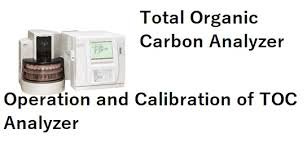Maintaining Analytical Integrity: TOC Analyzer Calibration Methods.

Calibration of Total Organic Carbon (TOC) Analyzer – Detailed Explanation
Introduction: A Total Organic Carbon (TOC) Analyzer is an essential instrument used to measure the amount of organic carbon in a sample, typically water. This is a critical parameter in water quality analysis for industries such as pharmaceuticals, environmental monitoring, food and beverage, and wastewater treatment.
To ensure accurate and reliable results, the TOC analyzer must be properly calibrated. Calibration aligns the instrument’s response with known standards, ensuring the output corresponds accurately to the actual concentration of organic carbon in the sample.
1. Purpose of Calibration
The main goals of TOC analyzer calibration are:
-
To verify instrument accuracy over a range of concentrations.
-
To ensure compliance with regulatory requirements (e.g., EPA, USP, ISO).
-
To detect and correct for any instrument drift or sensitivity loss.
-
To maintain traceability to standard references.
2. Principles of TOC Measurement
TOC analyzers typically follow these steps:
-
Oxidation: Organic carbon in the sample is oxidized to CO₂.
-
Detection: The resulting CO₂ is measured using detectors (commonly NDIR – Non-Dispersive Infrared).
-
Calculation: TOC concentration is determined based on CO₂ produced.
3. Calibration Procedure
a. Selection of Calibration Standards
-
Use certified TOC standards such as potassium hydrogen phthalate (KHP) for organic carbon.
-
Standards must be prepared in a clean environment using high-purity water (e.g., ultrapure or deionized water).
-
Use at least two to five calibration points (e.g., 0, 1, 5, 10, 25 ppm) to construct a linear curve.
b. Instrument Warm-Up and Cleaning
-
Allow the TOC analyzer to warm up as per the manufacturer’s recommendations.
-
Perform system flushing with blank water to remove contaminants.
c. Running Calibration
-
Blank Measurement: Run high-purity water (zero point).
-
Standard Injection: Inject each standard concentration.
-
Signal Recording: The instrument detects the CO₂ generated and plots response vs. concentration.
-
Curve Generation: A calibration curve is generated using linear regression.
d. Verification (Validation)
-
After calibration, run a known concentration as a verification standard.
-
Check that the measured value is within ±10% of the true value.
4. Frequency of Calibration
-
Initial Calibration: Upon installation or after major servicing.
-
Routine Calibration: Monthly or quarterly, depending on usage and SOP.
-
Drift Check: Periodic checks to verify no deviation from calibrated range.
-
Recalibration: If the analyzer shows abnormal results or fails verification tests.
5. Documentation and Compliance
-
Record all calibration data, including:
-
Standard lot numbers
-
Date/time
-
Operator name
-
Instrument ID
-
Calibration curve and regression coefficient (R² ≥ 0.995 is typical)
-
-
Maintain documentation for audit and regulatory review.
6. Troubleshooting Calibration Issues
| Issue | Possible Cause | Solution |
|---|---|---|
| Poor linearity | Contaminated standards or tubing | Prepare fresh standards; clean tubing |
| High blank reading | Residual TOC in water or system | Use high-purity water; rinse system |
| Inconsistent results | Injector problems or drift | Check injector, perform maintenance |
7. Calibration Types
-
External Calibration: Uses external standards for calibration (most common).
-
Internal Standard Calibration: Adds a known internal standard to correct variations.
-
Auto-Calibration: Some modern instruments support automated calibration routines.
Conclusion
Proper calibration of a TOC analyzer is critical to ensure data accuracy and regulatory compliance. By using traceable standards, following a strict protocol, and routinely verifying performance, laboratories can maintain reliable operation of TOC analysis systems.
🎓 Discover one of the best Quality Assurance courses available — click below to explore the course that’s shaping future QA skills.

